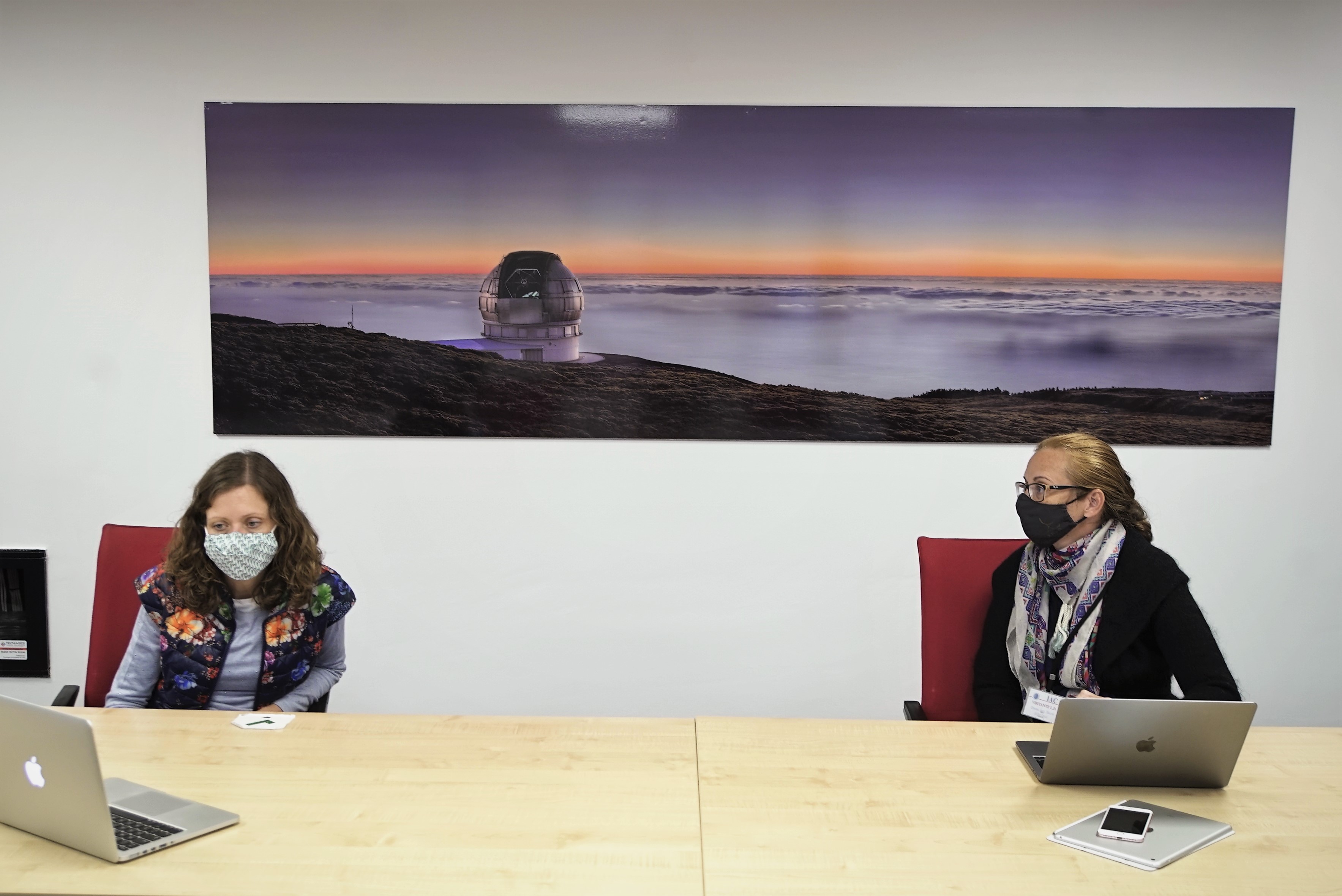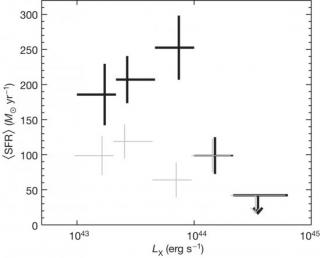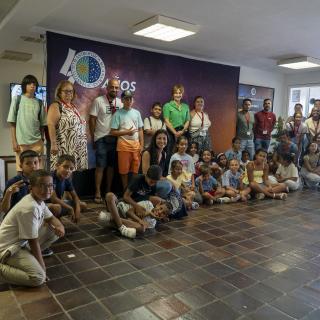For astronomers one of the biggest obstacles is the darkness of the Universe itself, above all the darkness caused by the gas and dust which surround active galactic nuclei, or AGN. These nuclei emit a huge quantity of energy produced by the supermassive black hole onto which matter falls at a considerable rate. The accretion processes are fundamental for the evolution of active galaxies. However these nuclei often remain hidden by the dusty structures, called tori, which surround the central black hole. Studyuing the properties of this circumnuclear dust, the accretion processes, and especially their connection with the evolution of the galaxies in the nearby universe is the main goal of the research which Omaria González Martín is carrying out at the Institute of Radioastronomy and Astrophysics (IRyA) of the National Autonomous University of Mexico (UNAM) at its Morelia Campus. With the aim of coordinating some observing proposals for the James Webb Space Telescope (JWST), due to be launched towards the end of 2021, and to strengthen lines of collaboration with the Instituto de Astrofísica de Canarias (IAC) the researcher has joined the Jesús Serra Visitors’ Programme, an initiative which promotes visits to the IAC by visitors of high international prestige.
Question. During your stay at the IAC you have collaborated in the preparation of several observing proposals for the JWST. What are the advantages of this telescope compared to others?
Answer. One of the main aims of this visit has been to contribute to the preparation of several observing proposals for the JWST, which will be launched towards the end of 2021 after over 25 years of planning and development. Although it has suffered some delays, it is the “Crown jewel” of astrophysical satellites. It will be a major leap forward in out ability to observe distant or faint sources in the infrared. With its 6 metre primary mirror, the largest every launched into space, it will for the first time let us observed those sources which due to their faintness have never been observed from the ground which such sensitivity. In addition, not only will it allow us to study the source as a whole, but it will also resolve its morphology, which has never been possible on such small scales.
Q: What is in the observing proposals which have been presented from the IAC?
A: Within the collaboration we have sent in half a dozen proposals, but I should pick out those led by Cristian Ramos Almeida, an IAC researcher, and I during my stay here. The proposals are related to the study of AGN. There is growing evidence that galaxies and their nuclei evolve together, so that the nucleus affects the evolution of the galaxy and viceversa. However we don’t really know how something as small as the nucleus can make the galaxy react to its presence. Cristina Ramos has a beautiful project, in which I am collaborating, whose aim is to study how the active nucleus can affect the galaxy, using a sample of active nuclei in the most powerful galaxies in the relatively nearby Universe. To be explicit the JWST will let us trace the winds produced by the nucleus, and study star formation to see whether the winds foment or reduce the formation of stars.
Another project led by me is the study of the properties of the dust in the active nuclei, a subject which we have been discussing for decades. At first it was thought that the structure of the dust was always the same for all active nuclei and that the differences we see in the different types of activity are due to their orientation on the plane of the sky with respect to our line of sight. In the past ten years there has been a real revolutionin this field. Now we now that this dust structure in the active nuclei is different for each type of source. My theory (and that of other collaborators) is that the dust evolves,and that every active nucleus we observe is a photo of a different momento in this evolution. The proposal we have sent will study a set of nearby active nuclei which we thing sample a range of different states of evolution.
Q: How can the Canary Observatories complement the observations made with the JWST?
A: All the proposals we have just sent of to obtain observation time on the JWST have complementary observations, or have been previously explored from the Roque de los Muchachos Observatory (ORM) on La Palma. For example I started the work on the evolution of the dust around active nuclei some time ago, when I was in the IAC as a postdoctoral researcher for 4 years, using the Gran Telescopio Canarias (GTC). This has been one of the few telescopes in the world which have observed in the spectral range emitted by the dust. Now, with the launching of the JWST we will make a great leap forward in quality, but we are prepared thanks to the infrastructures available to us in the Canary Observatories. This previous work has made us visible to the astronomical community, and has allowed us to be leaders in the field of study of nuclear activity in galaxies. Also the support given to me by the Visitors’ Progamme of the Jesús Serra Foundation is of vital importance to keep our research networks active, permitting interaction with collaborators who supply us with new ideas for using the installations of these Observatories.
The exploration of space is an endless source of questions
Q: What questions remain to be answered in your field of study?
A: The exploration of space is a limitless source of questions. Let’s imagine the first explorers of remote regions on Earth. Do you think that they came back from their journeys thinking that they new everything? Every time they learned something it opened the way to new unknowns. Science works that way too. In my field we have made many advvances in recent decades in oujr knowledge of active galactic nuclei, but there are still many more unkowns to decipher. Perhaps the questions which are most puzzling just now are related to the evolution of the galaxies. We need to understand how the AGN have participated in their evolutipn. We know that there must be some impact because it has been shown that they don`t evolve freely, but that they interact. However we are not finding it easy to understand the mechanisms which regulate this interaction. Perhaps another question very much in vogue in this field is related to the most obscured nuclei. Observatons of the Universe at cosmological distances predict a large number of these highly obscured nuclei. But we are not finding them, not even in the local universe. In fact I think that the JWST will cause a revolution in this area as well. Finally a question which is very interesting to me i show the mattter which feeds the nucleus is distributed, and whether these “food reserves” (mainly gas and dust) are the key to the understanding of the different classes of AGN and their evolution.

Q: How does the study of galaxy formation and evolution complement other areas of astrophysics?
A: For me, galaxy formation and evolution is everything. In one way or another, we are all contributing to the understanding of the evolution of the Universe through the formation and evolution of galaxies. For example, stellar physicists contribute to the understanding of the processes that produce star formation through the collapse of molecular clouds. This study is indispensable for understanding how galaxies evolve. Those who study the Sun use the nearest star to understand the physical and chemical processes that occur in stars that are ultimately the basic constituents of galaxies. Those who study planetary nebulae (explosions of stars) want to understand how the medium is enriched with elements so that the next generation of stars, fed by that medium, is different from the original. Those of us working on active nuclei help to understand the feedback processes between the galaxy and the nucleus. In doing so, we rely on the work of the entire community.
Q: If you had to pick out just one of the most important revolutions in Astronomy, which would it be?
A: There are many recent discoveries worth mentioning. For example the first image of the event horizon in the galaxy M87 with the complex interferometer making up the Event Horizon Telescope (EHT) or the confirmation of the existence of the Higgs boson with the large hadron collider (LHC). However if I had to choose just one I would take the detection of gravitational waves with the LIGO experiment. Over and above the impressive observational confirmation of a theory (which it shares with the first two discoveries I mentioned) for me the importance of gravitational waves is that they open the door to the study of the Universe in a different way. It is a historic achievement similar to the first time that we discovered that the Universe emits X-rays (for which Riccardo Giacconi, who recently died, won the Nobel Prize in Physics). It is as if, as well as our senses of taste, smell, touch, sight, and hearing, we had discovered a new sense with which we can detect new details of our surroundings. We astronomers have been granted a new super-power with gravitational waves beacuse as well as studying objects by their emission of light, or their gravitational fields, now we will be able to study them using the gravitational radiation which they emit at particular moments. There is still quite a way to go in this field to achieve sufficient sensitivity but in my view it is a line of research which will offer amazing advances in the next decades.
We are going to launch a pirate ship into space, whose deployment is a great technical achievement
Q: Why is Science in general, and Astronomy in particular, important for society?
A: Coming back to the JWST this satellite telescope is the proof of how scientific advance in our field pushes technolgical advance. We are going to launch a pirate ship into space ( a reference to the form of sail and mast on the satellite with its telescope), whose unfolding will be an outstanding achievement. To do that the consortia have developed pioneering technology which will be used in other developments on Earth and in space. This has already happened with other satellites which have been precursors to the worldwide communications network. But not everything is technology brought about by advances in Astrophyiscs. For me, Science is a reflection of the interest of human beings to increase their knowledge, and so it is inherent in humanity. If it is neglected we are neglecting a part of our being and one of the key differences between ourselves and the other species on Earth. I don’t understand how something so characteristic of our species is always in question, and is often the field most left aside by the political forces of society. Maybe those of us within Science should take part of the blame because we don’t know how to convince society that it must defend all the areas of knowledge and its growth. If those of us involved in this growth don’t look after it it will enter into a decline. This decline affects everybody. In the time of the current pandemic which has cut short so many lives and which is still worrying us all, we have seen how investment in basic Science in all fields must be maintained. We thought that pandemics occurred only in the third world or only in the distant past in another Europe. Clearly for that reason the study of viral diseases was not a priority in the first world. Now we have decided to support this line of research which will potentially cure many diseases which affect minority groups in society. We should not overlook any aspect of Science because all of them are important.
Q: What support do you think is needed for scientific research?
A: The support should be at all levels in society, public and private entities should give economic support to the development of knowledge. This Visitors’ Programme of the Jesús Serra Foundation is a great example of how to support scientists. Without progammes such as this we could not carry out our work. We researchers should contribute to education, both basic and specialized, as well as developing our own scientific carreer in a serious way. That way we will ensure that the investment offers a return to society and that it is committed to scientific advance.










